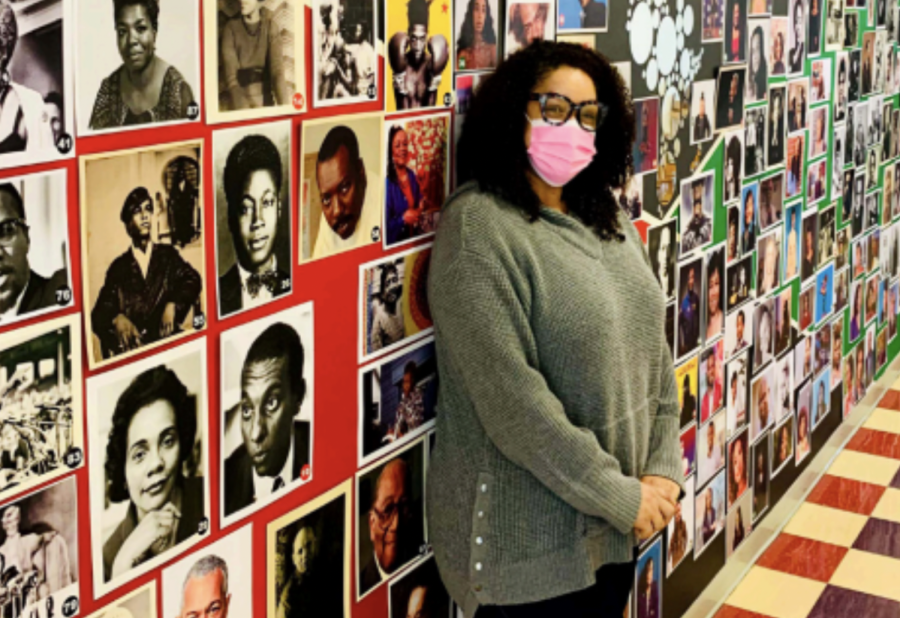‘Made with love’: Black history mural inspires reflection
May 4, 2021
Something big, bold, and beautiful—that’s the vision Upper School (US) English Teacher Alda Farlow had for the hallway between the theater and the library, where she undertook the creation of a giant mural now covered with images of 280 influential Black Americans throughout history. The effort began as a passion project for her during quarantine, she said.
“It was part of the bigger theme, which was celebrating Black pride, Black joy, and Black excellence,” she said. “And, in telling the story, I wanted people to understand that Black history isn’t just about a few characters in history that we hear over and over and over again. It’s always unfolding, and it’s more complicated.”
Ms. Farlow said she tried to render Black history in America by showing its past, present, and future and by featuring figures of varying levels of fame who have sacrificed something in order to make a change in the world.
“I wanted people to understand the myriad contributions by African Americans to the American story,” she said. “It’s not enough to just know who Frederick Douglass and Rosa Parks and Harriet Tubman are; [it’s important] to know that there are people today who are making changes and are fighting to make change.”
The background of the mural is an artistic expression of the Pan-African flag to emphasize all of humanity’s African roots, Ms. Farlow said, and several mirrors of different sizes also appear in the middle of the mural to add a personal dimension to the piece.
“I wanted whoever is looking at the mural to see themselves as important in the story of history,” Ms. Farlow said, “whether you’re African American or not.”
Seeing the faces on the mural as she walks down the hall has felt powerful for her as a Black woman, Ms. Farlow added.
“We’re all part of history. All of our stories matter,” she said. “It does sadden me that Black history has had to fight so hard for legitimacy as American history. My biggest hope is people understand that it’s all human history, and it all matters.”
Though Ms. Farlow conceived and directed the creation of the mural on her own, she had help from multiple faculty members, including US Library Co-Director Camille Hoven, who helped curate a list of individuals to include in the mural; US Math Teacher and Service Learning Co-Coordinator Meena Kaur, who helped paint the wall behind the pictures; US Science Teacher Terry Cox, who helped lay out the images; and US Film and Video Teacher Chris Gaines, who created the list of names alongside the mural with an embossed Pan-African flag in the background.
Ms. Hoven said that in her opinion, one theme unites the wall.
“I hope everyone looks at the mural and sees love,” she said. “It was made with love. The people on it are loved, and the people reflected in the mirrors are loved. It’s true that there is a lot of hate in the world, but I do think there is more love, and that can be powerful.”
Ms. Kaur said she likes the mural for its powerful themes.
“I like that there are mirrors in the center so students can see themselves amongst the important historical and present figures. I like that we painted the wall behind the images in black, red, and green— the colors of Black history month,” Ms. Kaur said.
“I like that students have a space to see images of people who are not typically put at the center. I like that it takes up a whole wall to present so many people and that we could have used even more room.”
Mr. Cox said every day when he passes the mural on the way to his office, he feels many emotions.
“Seeing all the faces up there and their contributions, obviously, to our history—not only as African Americans or [people] of color but just to American history—it brings up a great sense of pride. [I] just look at that and stand in the center and think about what my contribution will be to the history,” Mr. Cox said. “But sometimes, it also brings up a great deal of disappointment in myself for not knowing more of the individuals who are up there.”
While Gabby Blanco ’21 wishes there were more pushes for change at the school, she appreciates the prominent placement of the mural, she said. “I think my favorite part [of the mural] is [that] it’s unavoidable, and I like that I can educate myself on figures that I wasn’t aware of before,” she said.
Sydney Bernstein ’22 said one quotation that appears high up in the mural particularly strikes her.
“[It’s] the one that says, ‘If you’ve ever wondered what you’d do during slavery, the Holocaust, or a civil rights movement, you’re doing it right now,’” Sydney said. “That reminded me that even if you’re not outright racist, if you’re not making efforts to be anti-racist, you’re part of the problem.”
The school plans to keep the mural up until at least next February. Before then, Ms. Farlow said, she hopes to hold a competition where students match as many pictures in the mural to the adjacent names as they can and to invite community members to add their own photographs of influential Black Americans.

